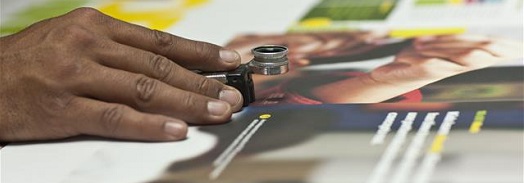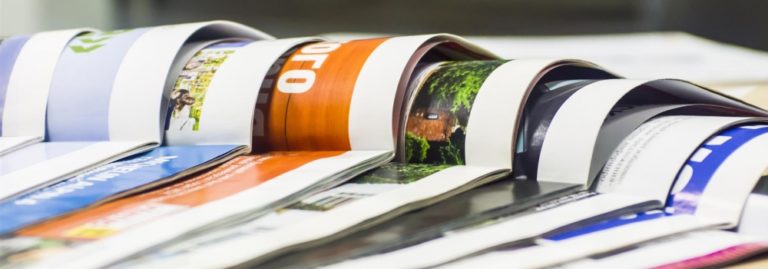By Michelle Chretien and John P. DiVincenzo
Have you noticed that as the world goes digital, the meaning of words change? Think window, spam, share, apple … even the wee preposition “at” has expanded its role in language. We see the term “print” moving quickly in this direction. In the near future the concept will swell in ways we hardly can imagine. Paper, for example, no longer will be a brainless tool to push around and pile up. It will be intelligent. It will interact with humans and help them navigate the world.
John DiVincenzo sees the printed package as an important gateway to the future

In the printing world, digital printing has radically changed the way we reproduce text and images. It’s expanding across many key print applications (such as magazines, direct mail and marketing brochures) because it enables more targeted messaging, making items more relevant to the person who is reading it. This allows “print” to play better across multi-media, and to be fundamentally worth more to customers.
A good example where digital print will create even more value in the future is in the world of packaging. In this expanding market, manufacturers are looking for new ways to address wide-ranging consumer needs and expectations. Digital print allows for more intelligent, targeted and even individually tailored packaging. For instance, a digitally printed medication package could include special information about critical drug interactions based on the patient’s particular condition and current medication regimen.
Or think about intelligent packaging in a grocery store that interacts with your smartphone or wearable device. Through a network of interconnected devices, a loaf of bread would “know” that you’re only looking for gluten-free products and glow to attract your attention; smart milk cartons could flash to remind you that your dairy supplies are running low at home. (Your house is also “smart” and connected to the network). And, the recipe you “liked” on Facebook last night? Imagine the packaging of each ingredient sending signals to your smartphone about its location in the store.
I also see packaging as the first major gateway to integrate 2-dimensional printing with other forms of print such as 3-D and printed electronics. In other words, not only will we be able to print tailored and interactive packages, but someday we should also be able to print what’s inside the package at the same time.
Michelle Chretien says 3D printing changes everything
Both 3D printing and printed electronics are already finding applications in areas from healthcare to manufacturing. Reduction in the size and cost of 3D printers is moving the technology from industry to hobbyists and students and eventually toward the general population. As these technologies grow, mature and increasingly intersect, I think we will interact with non-traditional print more and more.

As 3D printing makes its way into our homes and offices it’s not hard to envision a future where we will use print to generate both the form and function of everyday objects. Today, as a research scientist, I can use a 3D topographical scan of my face to help design and print the perfect pair of eyeglass frames. Someday soon I also may use printing to customize those eyeglasses with sensors and displays that will help me to interact with the people and objects around me. Maybe my glasses have a scanner that sends images and data to my home 3D printer so that the shoes I window-shopped this afternoon are waiting for me when I get home.
3D printing already is being explored by the medical community to print tissues and organs; as 3D printing becomes more ubiquitous, how might this change healthcare or even first aid? As parents, will we someday be able to print a better bandage – one that contains the custom treatment that our Web-based family doctor has sent over to our home-based medical printer. The possibilities really are endless. 3D printing and printed electronics are changing the game today and over the next decade may re-write the rules entirely.
John DiVincenzo is vice president of strategy and marketing communications for the Xerox Graphic Communications Business Group. In this role, John leads long-range strategic planning and coordinates market participation and investment choices for the Graphic Communications Business. He also manages global marketing communications programs for the production business in support of all Xerox channels, and is responsible for driving sales of Xerox technology in Asia through the Fuji Xerox partnership.
Michelle Chrétien is a materials scientist who leads the Materials Science Area at the Xerox Research Centre of Canada where she also serves as the portfolio manager for strategic research. She has published 21 scientific papers in peer-reviewed journals and holds 50 U.S. patents on curable inks and other marking technologies. In 2010 Chrétien was recognized by PrintAction as one of the Canadian printing industry’s Top 35 Under 35 for her technological contributions.
Subscribe to Simplify Work and receive email updates when we publish a new article.
We asked Xerox people:
They’ve been predicting a “paperless office” since the 1970s. Will printing ever truly vanish from the workplace?
In an increasingly digital future, where will we continue to see print?
More than three-quarters of those who responded feel that print will always exist in some form. “Print is the enduring record of our time. Look at the Aztecs, the Egyptians … print endured. Digital records have a lifespan [that does not stretch] into eternity.” “Until we have a digital future that is failsafe and always-on, paper documents will continue to live” as emergency backups. Even if there comes a day when digital records “don’t need batteries,” only paper is “able to survive ‘digital sabotage.’” But one thing seems inevitable: “once these young children are old enough to go all-digital, they will.”
As the next generation adopts digital, the role of paper will evolve. Print may become “a form of sculpture… you can feel it, and it has mass, and it has a visual impact.” “Print tomorrow will be like calligraphy is today.” And while “there are plenty of options for digital signatures already” so inked signatures may not be necessary, the act of two people, companies or nations signing a paper document will become a “commemorative” event.
Of course, the way we think about “print” may change entirely. “The use of paper … may [decrease] to virtually nothing, but the act of printing will continue to rise. It’s just that we will print different things: food, clothing, circuits, 3D models, a cup of perfect tea.” Future generations “will need to be reminded that not too long ago, [‘print’] meant putting ink on paper.”
But what might take the place of ink-on-paper? Perhaps we’ll develop a new digital “re-usable media [with] the portability of paper (i.e., the size, weight and thickness).” Or perhaps “implants in our brains will be able to impose information onto every surface we can see.”





Great article……promotes thought!
Troy Mobley
Thanks for the kind words, Troy. If you liked this one, you might also like these other articles that are part of our Next 75 series of forward looking commentaries.
#Next75
This is my first time go to see at here and i am truly pleassant to read all at single place.